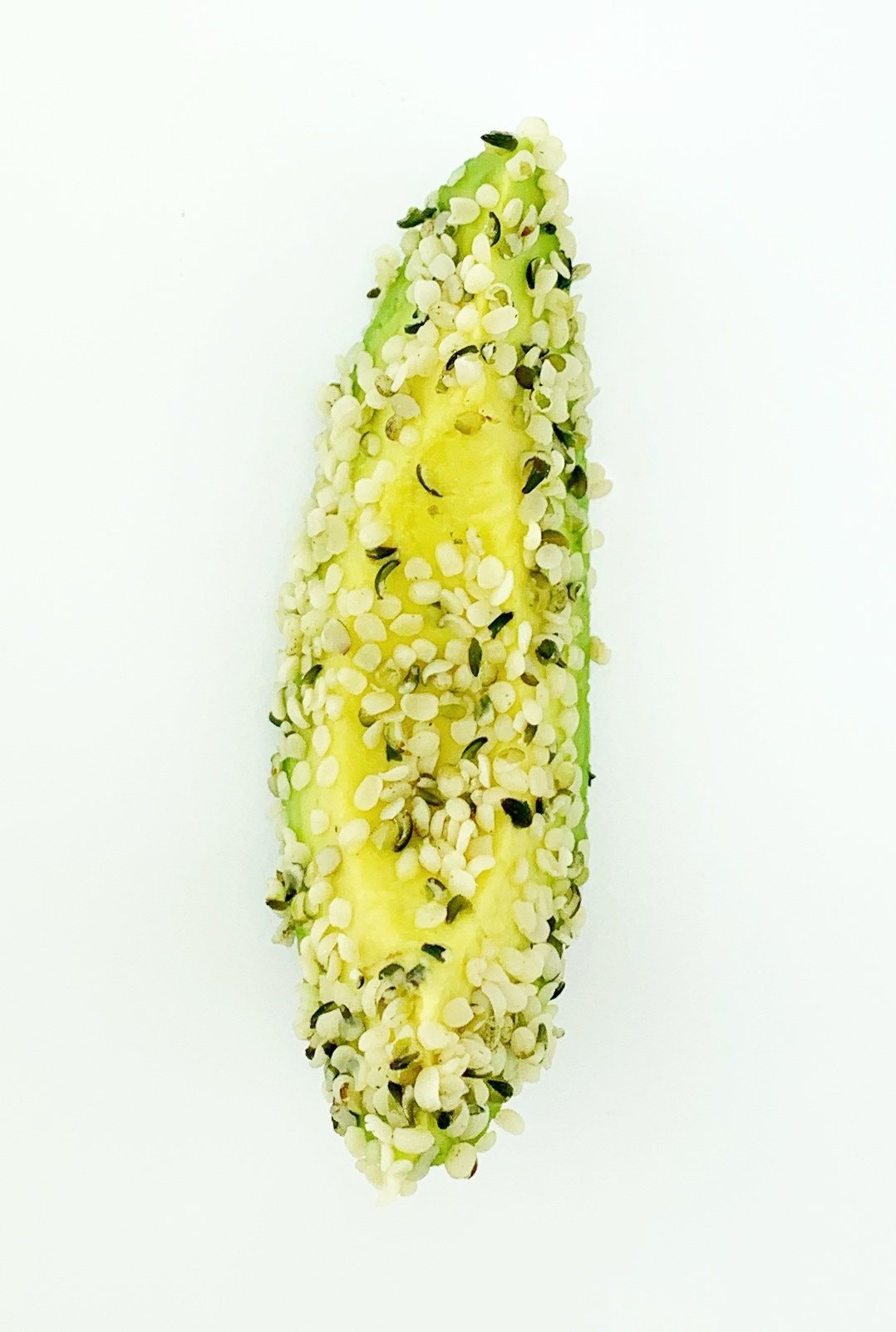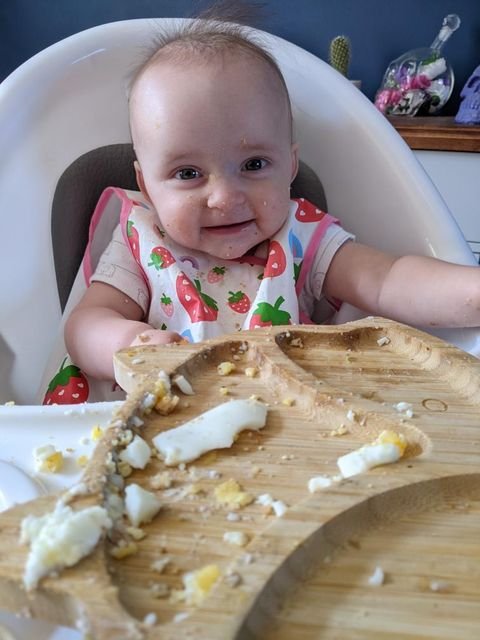Making the Perfect Hard Boiled Egg for Baby
So your baby is ready to start solids and you want to introduce a food that is packed with nutrients, supports brain development, and an ideal texture during baby-led feeding?
Cooked eggs are an excellent addition to a baby's diet and widely recommended by experts when introducing a baby to solid foods.
In this article, we’ll explore how to cook the perfect hard-boiled egg for a baby, how to introduce eggs during baby-led weaning, alternative ways to serve eggs to babies, and answers to your frequently asked questions about the safety and benefits of eggs during infancy.
Why are hard-boiled eggs optimal for babies?
There are so many nutritional benefits of eggs for babies. A report published by the advisory committee to the Dietary Guidelines for Americans (a top group of nationally recognized scientists) recommends eggs for infants and toddlers when introducing complementary foods.
They are an excellent source of 8 essential nutrients including lutein and choline which are critical for supporting a baby’s brain growth and development. In fact, one large egg meets a baby’s choline needs for the entire day. Eggs also contain vitamins A, D, E, and K along with plenty of B vitamins to support your baby’s health. Be sure to include both the egg white and yolk; egg yolks are where most of the nutrients in eggs are located.
Cooking hard-boiled eggs for baby
13-month old fellow nibbling on a hard-boiled egg. Thank to his parents for sharing!
Hard-boiling eggs is one of the simplest recipes you can make when strapped for time. In about 15 minutes and with little effort, you'll have a healthy, nutrient-dense protein food for your baby.
Cooking hard-boiled eggs may be simple, but achieving the perfect hard-boiled egg is no small feat. When we boil eggs too long or too hard, a chemical reaction occurs between the sulfur and hydrogen in the egg, causing a grayish-green ring to form around the yolk. It's unsightly, but not at all dangerous. To avoid the grayish-green ring, there are a few cooking techniques you can follow.
Technique #1, the “no-boil” method
With this technique, the residual heat from the boil allows the eggs to cook thoroughly without overcooking. Ensuring your egg is fully cooked before serving it to a baby is important. The yolks and egg whites should be completely set to destroy any pathogens that can lead to food-borne illness.
Step 1: Fill a saucepan about halfway with cold water. Gently place eggs at the bottom of the pan and add enough additional cold water to cover the eggs by at least an inch. If you’re concerned about an egg cracking, add a teaspoon of vinegar to the water to keep the whites from leaking.
Step 2: Bring the water to a rolling boil on high heat. Once the water has reached a boil, turn off the heat, cover, and let the eggs sit for 15 minutes if preparing the eggs for an infant (12-13 minutes if you are making the eggs for an adult). If cooking a large batch, you can remove a single egg and check for doneness, if undercooked, leave the remaining eggs in the water for a couple of minutes longer.
Step 3: Strain the hot water from the pan, and carefully place the eggs into an ice bath or run them under cold water until they are cooled.
Technique #2, the “simmer” method
Step 1: Fill a saucepan about ¾ of the way with cold water. Bring the water to a rolling boil on high heat.
Step 2: Gently place the eggs in the boiling water and lower the heat until the water reaches a gentle simmer. Cook for 15 minutes if preparing the eggs for an infant (10-12 minutes if you are making the eggs for an adult).
Step 3: Transfer the eggs into an ice bath to cool.
Storage tip: Hard-boiled eggs can be stored in the refrigerator for up to 1 week with shells on.
Tips for easier peeling of hard-boiled eggs
→ Place eggs in an ice bath to cool immediately after cooking
→ Peel eggs under water to help remove the shell
→ Crack the eggs at the rounded end, this is where the air pocket is located and allows for easier peeling
How should I serve hard-boiled eggs to my baby?
The soft texture of eggs is ideal for babies, who can pick up wedges of hard-boiled egg as a finger food and easily mash hard-boiled eggs in the mouth before swallowing which greatly reduces the risk of choking.
If you’re following baby-led weaning, be mindful of your baby’s developmental grasp when serving hard-boiled eggs. If your baby uses a palmer grasp (usually up until about 9 months of age) cut hard-boiled eggs into pieces about the size of a pinky finger (about ½ inch wide, ½ inch deep, and a few inches long). If the baby is using a pincer grasp, (usually develops at around 9 months) cut hard-boiled eggs into chickpea-sized bites.
Building balanced meals for babies
Although eggs are packed with nutrition on their own, it helps to pair them with foods from additional food groups to create balanced meals for babies. As a pediatric registered dietitian, I help families build balanced meals for their babies that include three major building blocks, as outlined below.
Baby’s meals should ideally include one of each of the following:
Avocado wedge rolled in hemp seeds - example of an energy-dense food with healthy fats.
A protein food that is iron-rich
A fruit or vegetable (preferably one that is rich in Vitamin C)
A food that is energy-rich (preferably with healthy fats)
Eggs are an iron-rich protein food, so pairing a hard-boiled egg with a vitamin C-packed fruit or vegetable like blackberries or steamed bell peppers helps balance the plate. To add the energy-rich component, add a strip of buttered whole-grain toast, some full-fat cheese, a wedge of avocado, strips of pancakes, or one of the other energy-dense foods found in my best-selling BLW book.
Here are some examples:
Meal 1:
Hard-boiled egg (iron-rich) with steamed green beans (vitamin C) and avocado (energy-rich)
Meal 2:
Hard-boiled egg (iron-rich) with strawberries (vitamin C) and full-fat Greek yogurt (energy-rich)
What About Egg Allergies During Infancy?
With eggs being one of the top 9 most common food allergens, it’s wise to be extra observant when babies eat eggs for the first time. However, both the American Academy of Pediatrics and CDC recommend introducing potentially allergenic foods (including eggs) when a baby is ready to start solids, to significantly reduce the child’s risk of developing a food allergy.
If your child has severe eczema and/or you have concerns about your baby’s level of risk for food allergies, speak to your pediatrician.
This 7-month-old cutie had fun exploring hard-boiled eggs! Thank you to her parents for allowing me to share their picture.
Helpful tips when introducing potential allergens to baby
Pick a day when you can be attentive for at least 2 hours after the meal.
Start with a healthy, happy baby so you don’t confuse a teething issue or virus with an allergic reaction.
Offer a tiny amount, and monitor for about 10 minutes. (Symptoms of a reaction include but are not limited to vomiting, hives, itching around the mouth, shortness of breath, or repetitive cough.)
If no reaction, continue to feed the baby the rest of the portion and monitor over the next couple of hours.
Repeat the process the next day and again the next, which is usually enough to establish that a baby is tolerant. It’s important to keep introducing the potential allergen 2-3 times a week during the first year of life. Initially, allergens should be introduced one at a time so that if there is a reaction, it’s easy to determine which food is responsible.
For more tips, see this early infant feeding blog post and get an entire roadmap to early and frequent allergen introduction (with over 30 recipes) in my Safe & Simple 12-Week Meal Plan.
If you’re getting ready to start your baby on solids, download my FREE Baby-Led Feeding Essential Checklist to make sure you have everything you need to get started. You might also want to check out my new online course for parents, based on my best-selling book which will walk you through the whole process of starting solids using a baby-led approach.
Thank you to my dietetic intern, Erica Jackson for her contributions to this article.











